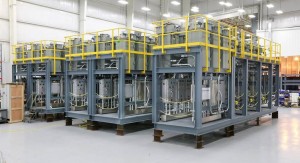With more stringent regulations affecting FCC units, Refinery Operations approached the General Atomics Electromagnetic Systems Group (GA-EMS) for elaboration on environmental and fuel quality issues impacting FCC operators.

Skid mounted electrostatic separator design provides alternative to mechanical filtration for catalyst fines removal.
What followed was a one-on-one discussion with Victor M Scalco (vic.scalco@ga.com), Business Development Manager, Gulftronic Electrostatic Separators, Apparently, each electrostatic separator based application, such as the Gulftronic GA-EMS application, which uses an electrostatic process to polarize, capture and removal all catalyst fines, deals with challenges unique to a particular facility’s FCC/RFCC operation, as noted in the following discussion:
Refinery Operations:
Now that there’s a history of 50 or so modular GA-EMS electrostatic separator units in operation, what trends are you seeing that will impact those refiners trying to control downstream contamination from FCC catalyst fines and other particulate matter?
Scalco:
This answer is twofold: First, Most of the projects to control downstream contamination issues are capital expenses. Capital projects are difficult to fund and have been a common trend for each refinery when it comes to the “bottom of the barrel.” This is even more evident as the cost of a barrel of crude falls below $50.00/barrel.
Another major problem is that refinery margins are shrinking. Refinery margin may be good in an odd month, but the prognosis is that these margins are going to be under pressure. Consumption of petroleum products is decreasing and even in China, the demand is not growing. This descalation of demand will ultimately reduce the focus on the least profitable process streams
Refinery Operations:
A previous RefComm® conference presentation (https://refiningcommunity.com/automation-separation-bottom-of-barrel-return/) concerning the GA-EMS electrostatic separator focused on removing increasing volumes of FCC catalyst fines. Against this backdrop and going forward beyond 2016, can you point out any “surprises” encountered with those FCCUs processing a blend of metals contaminated asphaltenic crudes AND very light crudes (e.g., shale based LTOs)? How does that affect separator design — if at all (e.g., more sensors and analyzers required)?
Scalco:
In order to look into the future of separation with GA-EMS technology, the increase in demand for production is key. Larger throughputs with increased concentration of contaminates will demand processing on a larger scale. We have already begun looking into increasing the size of the GA-EMS unit to handle processing product by a factor of three times (3X) the unit’s current throughput.
Sizing for today’s refiners requirements and FCC /RFCC production volumes are causing issues for all filtration, even settling, as the economics built into producing high value clarified slurry oil (CSO) to meet today’s market is only as good as the facility’s separation ability. If you increase the solids or increase throughput, your separation abilities have to keep up. At GA-EMS we have developed an online sensor to assist the Electrostatic Separator to actively react to these changes
Refinery Operations:
Elimination of catalyst fines and other particles down to the submicron level seems to be the new narrative for many of the roughly 84 or so FCCUs currently operating in the U.S. How do you see this affecting the future of mechanical filtration, not just in North America but elsewhere?
Scalco:
As more catalyst is being used to process heavier crudes along with the presence of more “tight oils” being processed, the fouling and need to remove these submicron particles is essential to increased production. As sighted in the 2014 AFPM Annual Meeting in San Antonio, separation of fines is becoming a major focus for most refiners. Only three technologies really exist: tank settling, mechanical separation and GA-EMS Gulftronic Electrostatic Separation. Per UOP and licensors of RFCC technology, sintered metal cartridges are not recommended due to the increase in asphaltene blockage as well as waxes that block these filters and create costly maintenance repairs, not to mention the profit lost in off spec product.
Submicron fines are also a problem for mechanical filtration, including their long settling residence times, while also completely seeping through mechanical filters. In contrast, electrostatic separation collects these submicron fines immediately, using their dielectrical properties to remove fines from the process.
The need for a solution based on electrostatic separation has been voiced by domestic as well as international refiners.







Leave a Reply
You must be logged in to post a comment.